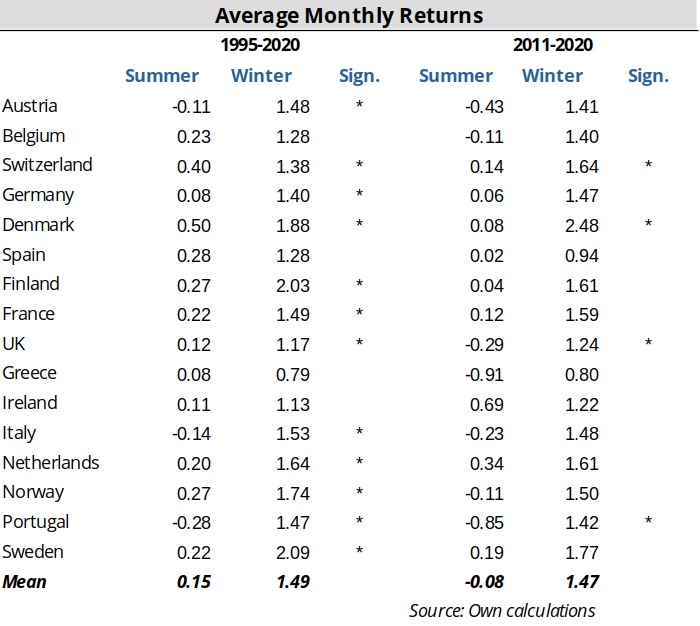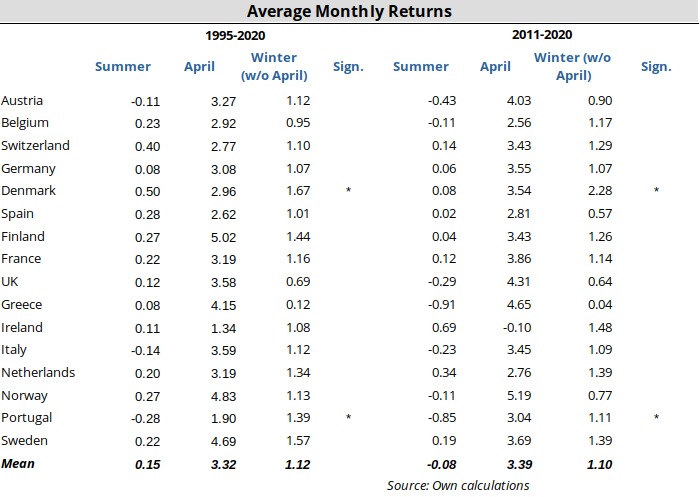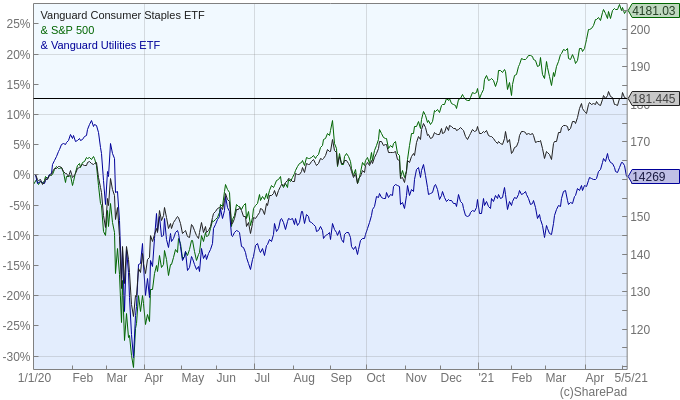Sell in May – and see you in October

Sell in May and go away, says the old Wall Street adage. If you invest long-term but like to enhance your returns, it’s time to pack your bags and take a deserved break for six months! That’s right – six months. See you in October! Not convinced? Let me show you some data about what is known as the Halloween effect.
Traders on Wall Street often complain about dismal stock returns over the summer in comparison to the rest of the year. And when they say summer… well, they mean May to October. A very long period of half a year! Sticking your neck out by investing in the market during this period doesn’t pay off, as the equity premium is near to none, if not negative, they say.
Is it true? Is there a summertime effect in stock returns?
The short answer is yes, there is such an effect.
Is it strong enough for me to care?
Let me use the example of the UK for the period 1995 – 2020. The average monthly return for the winter (November to April) has been 1.17%. The same return for the summer (May to October) has been 0.12%. In rough terms, if we compound those monthly averages, we get a figure of 8.00% per year. An investor keeping his money in the stock market during the winter and in a bank account during the summer would get 7.23% per year (all these rates of return are net of the risk-free rate).
Should I stay or should I go?
The evidence points to dismal returns for staying invested during the summer. All you would have achieved during the last 26 years in the UK, would be to enhance your return from 7.23% to 8.00% while doubling the investment time. On the one hand, it’s better to get 0.12% per month than nothing. Thus, if you don’t have any better uses for your money during the summer, you may wish to keep the money invested the whole year. On the other hand, investing in the stock market involves risk. A return of 0.12% per month converts into a compound annual return of 1.45%. This is a very low equity risk premium, which you may deem too short for the risk taken. If that’s the case, keeping the money invested during the summer may be an unsound option on a risk-adjusted basis.
A deeper look at the Halloween effect
The Halloween effect has been identified not only by investors and traders but also by academics. In 2002, Bouman and Jacobsen studied the effect formally, covering 37 countries, both developed and emerging, for the period 1970 – 1998. They found the Halloween effect in 36 out of 37 markets. In many instances, returns were even negative during the summer. This evidence supports the adage sell in May and go away.
Calendar effects are always puzzling. If we all know about them, why do they still exist? As far as the efficient markets theory goes, we would expect calendar effects to disappear. In anticipation of the extra returns coming in the winter, prices would start rising before the winter, improving the return of the summer. Using the same reasoning, in anticipation to the low summer returns, prices would decline before the summer, thereby impacting winter returns. This adjustment would remain in place until there’s no material difference in returns between summer and winter. However, Jacobsen and Visaltanachoti revisited the previous study in 2009 and found the effect still applied to data covering 1998 – 2007. The average return for the winter period was 9.35% but 1.02% for the summer period on their study covering 19 developed countries.
A number of explanations have been advanced, including a seasonal affective disorder, changes in risk aversion due to vacations, changes in market liquidity, changes in behaviour due to temperature changes, and many others. But the issue remains open.
In recent research, academics have been targeting industries and sectors to better understand the source of the Halloween effect. Interestingly, Jacobsen and Visaltanachoti say that there is a sector rotation strategy that is capable of enhancing returns. It mainly consists of picking the consumer sector during the summer and the production sector during the winter. Stocks in consumer staples, which constitute non-discretionary consumption, and utilities usually perform the same the year round and are the best bets for the summer. During the winter, everything connected with production does very well. This includes automobiles, coal, construction, machinery and textiles, they say. As consumer staples and utilities usually have a beta below one, this strategy basically involves investing in a defensive portfolio during the summer.
Looking at my own data
I have a lot of data sitting inside my computer for 16 European markets for the period between 1995 – 2020, so why not take a look at it and check whether the Halloween effect is large or not? I just set an econometric model to take into account the possibility of returns being different during winter (Nov-Apr) and summer (May-Oct). The results are summarised in the table below. Additionally, to take into account the possibility that the Halloween effect is losing strength, I did the same analysis but constraining the data to the period 2011 – 2020.

Each column of the table shows the average monthly excess returns (returns after discounting the risk-free rate). There is a Sign. column which indicates the statistical significance of the winter return, where an asterisk means the results are statistically meaningful.
The first thing that we notice is the large difference in returns between summer and winter. On average these European markets returned 0.15% monthly during the summer but 1.49% during the winter. Such a result is statistically significant for 12 of the 16 countries and includes the UK. In Scandinavian countries the effect is particularly large. Just look at the number for Sweden, Finland, Denmark and Norway. For these countries, the average monthly return is near or above 2 during the winter. In Portugal, Italy and in Austria, investors have been paying for the privilege of investing during the summer.
Let’s now look at the data for 2011-2020. The average monthly excess return is -0.08% for the summer and 1.47% for the winter. In Austria, Belgium, the UK, Greece, Italy, Portugal and Sweden, investors have been losing money during the summer. There’s no doubt there is a strong Halloween effect in Europe. However, these results are only statistically significant in 4 countries against 12 for the whole sample. In the UK, the effect is large and the difference between summer and winter is still significant. With the average monthly return being -0.29% during the summer, there’s a good reason for the British to extend their vacation, starting this month.
It’s all about April
There’s no doubt that the winter is better for stocks than the summer. However, many traders point to April as the game changer. They say that April is what drives winter returns higher and above summer returns. Is it true? Let’s take a look.
I created another model, this time splitting not only summer and winter but also detaching April from winter. The table below summarises the findings.

While winter is still the winner, the month of April alone appears 3x better than a winter month (now Nov-Mar). The average returns for April range between 1.34% for Ireland and 5.02% for Finland. In certain cases, winter loses the appeal it had. This is the case for Greece and, to some extent, for the UK. While there is still a noticeable difference for the average returns between summer and winter, this difference is now statistically significant only for Denmark and Portugal.
Putting it all together
If you’re still not convinced about leaving the market during the summer, then you can at least try to match the sectors that perform better during this flat period. As I already mentioned above, when Jacobson revisited the data on the Halloween effect, he also investigated the outperforming sectors, pointing to anything consumer related, in particular, non-discretionary expenses that are mainly inside the consumer staples sector. Another good sector is utilities, which includes electricity, water and gas. Both consumer staples and utilities are defensive sectors. They are less exposed to the business cycle. Furthermore, they’re less exposed to the summer/winter cycle for similar reasons. Market betas on these sectors are usually less than one, which may be a good thing at a time when the market seems overbought and to give you a peaceful summer.
There are several passive investment options to target consumer staples and utilities. To track the US consumer staples sector, I like the Vanguard Consumer Staples Index Fund ETF (NYSEARCA:VDC). It invests in 96 stocks, including giants like Procter & Gamble, Coca-Cola and Colgate-Palmolive. Its market beta is around 0.60, as the nature of this fund is more on the value than on the growth side. I like it because it closely tracks the sector, which is its key objective, and comes with a very low expense ratio of 0.10%. An alternative to track a global consumer staples sector is the iShares Global Consumer Staples ETF (NYSEARCA:KXI). It invests in many of the US giants held by VDC but additionally includes non-US companies like Nestle, Diageo and Loreal. The expense ratio comes a bit higher at 0.46%, which is not unusual for an international ETF.

To track the US utilities sector, I like the Vanguard Utilities Index Fund ETF (NYSEARCA:VPU). It invests in 90 companies, including NextEra Energy, Duke Energy and Exelon. Similar to VDC, the expense ratio comes at just 0.10%. This fund is even more defensive than the consumer staples equivalent, as its beta is currently 0.37. For an international option, I like the iShares Global Utilities ETF (NYSEARCA:JXI). More than 60% of its holdings are US companies, but it adds an international layer to it, including companies like Iberdrola, Enel and National Grid. JXI trades with an expense ratio of 0.46%.
As we saw here, there’s a very good reason for Wall Street traders to say sell in May and go away. Selling in May and returning by Halloween time isn’t much different than staying invested the whole year, with the advantage of not incurring any risk. In certain markets, staying invested during the summer appears to be a persistently losing strategy. That has been the case in the UK for the last 10 years. Therefore, for those who keep their funds in the market, it pays to rotate sector exposure and carefully select the markets. If you prefer not to take risks, then have a nice summer. See you in November!
Notes:
Key research mentioned:
Bouman, S., & Jacobsen, B. (2002). The Halloween indicator,” Sell in May and go away”: Another puzzle. American Economic Review, 92(5), 1618-1635.
Jacobsen, B., & Visaltanachoti, N. (2009). The Halloween effect in US sectors. Financial Review, 44(3), 437-459.
Article data:
The data used for the calculations in the article is made available upon request.
The saying is sell in May, go away, don’t come back till Ledger Day.
The St Ledger is on 11th September this year, not October.
Should we Sell in May and Go Away?
https://www.youtube.com/watch?v=t7mFAX8rLKw